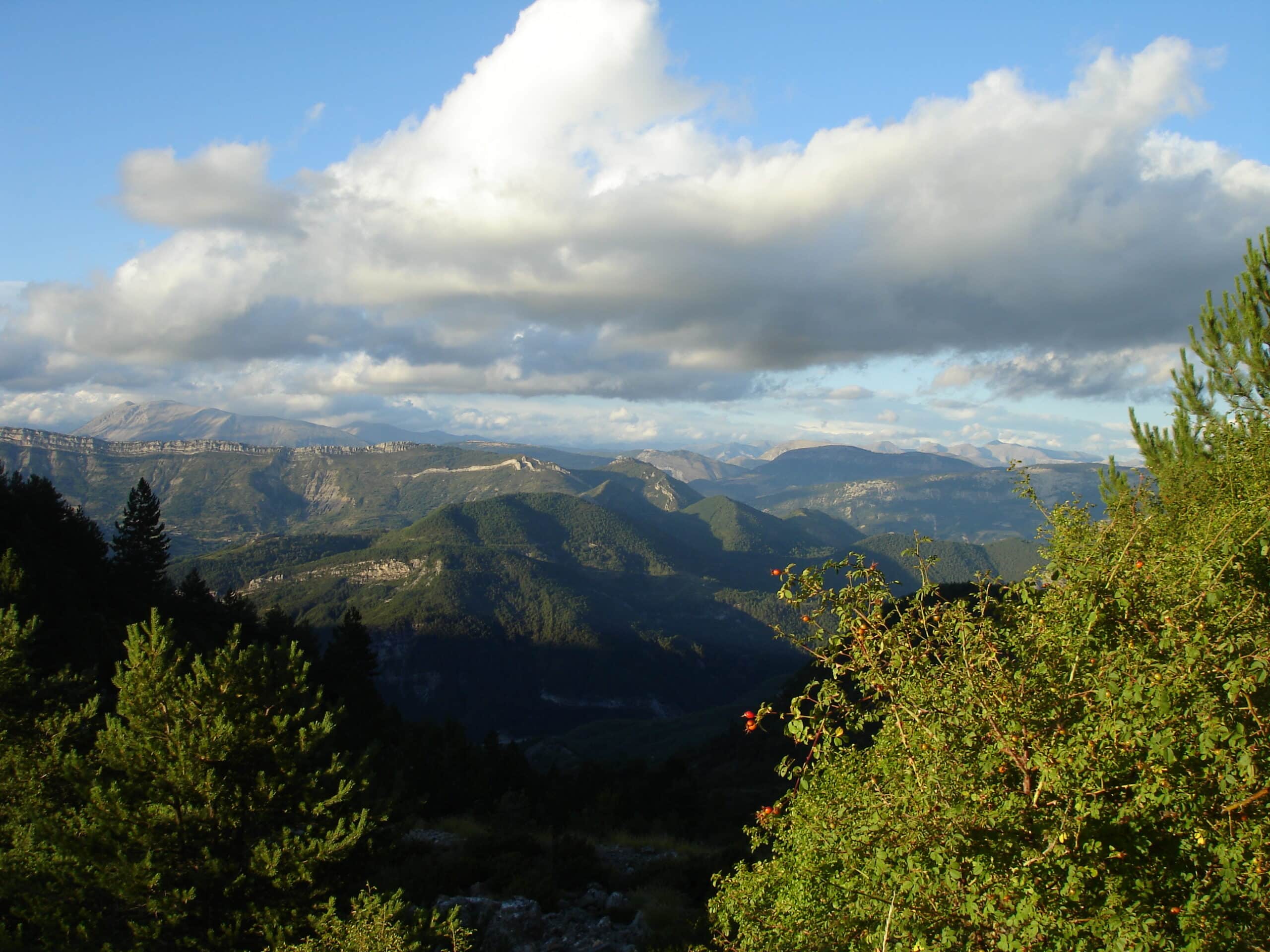The Southern Alps are characterized by a climate combining mountain and Mediterranean influences. It’s cold in winter, hot in summer and very dry in summer. The plants that have made their home here have therefore had to adapt to more difficult living conditions than in other regions. And they have succeeded remarkably well. Exploring these mountains is a treat for the inquisitive botanist.
Fruit under the larches
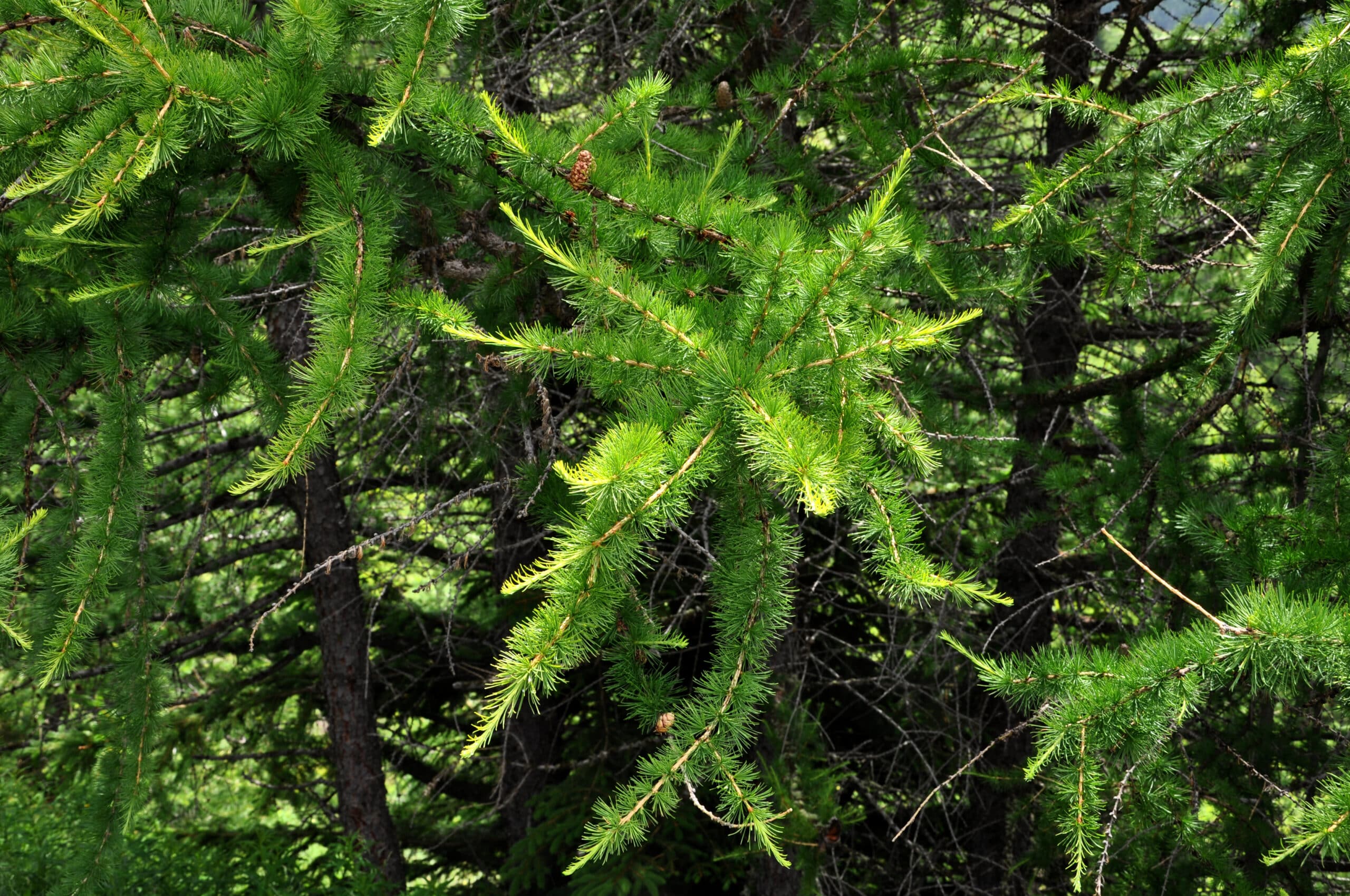
The airy larch forms the forest floor of the inner Alps, where the air is driest. It is the only conifer in our region to shed its leaves in autumn. It then dons a superb yellow-orange coat, contrasting sharply with the pure blue of a cloudless sky. You must see this admirable bichromy reflected in the mirror of Lac d’Allos or in the liquid pearls of the Vallée des Merveilles.
The trunk, with its thick brown bark split into slabs, can reach imposing sizes. It produces an orange-colored wood that is highly prized for framing and cladding. The very fine, light-green leaves are grouped in clusters of 15 to 20 on woody protuberances along the branches. The tree bears small cones.

Like all conifers, young larch shoots are edible. Their tangy, slightly resinous flavor makes them a pleasure to peck at as you pass by. They can also be added to salads or made into syrups.
The ground of dry pine or larch forests is covered in places by a dense carpet of tough, shiny leaves, whose rounded shape is reminiscent of boxwood (Latin: buxus ): bearberry spreads its tortuous, reddish-brown twigs in all directions, with smooth bark. The pinkish-white flowers, bell-shaped and narrowed at the top, give rise to large red beads. Their mealy, tart, astringent pulp is a little disappointing – especially for a close relative of the bilberry and cranberry… The plantigrades, who were less fussy, gorged themselves on “bear grapes”. This is the double meaning of bearberry’s scientific name, Arctostaphylos uva-ursi. The Greek arctos and Latin ursus refer to the bear, and staphylos like uva means “grape”.
Cooked into compote, strained to remove the seeds and suitably sweetened, fruit is not bad. They can also be crushed and mixed with flour to make pancakes or bread. Once dried, they were ground and sieved to provide a powder for making porridge. North American Indians mixed it with animal fat to make pemmican. Rich in carbohydrates, bearberry pulp is highly nutritious.
In Russia, the leaves were used to make a bitter tea called kutai. Their decoction is considered a remarkable antiseptic for the urinary tract, and has been used for this purpose since the Middle Ages.
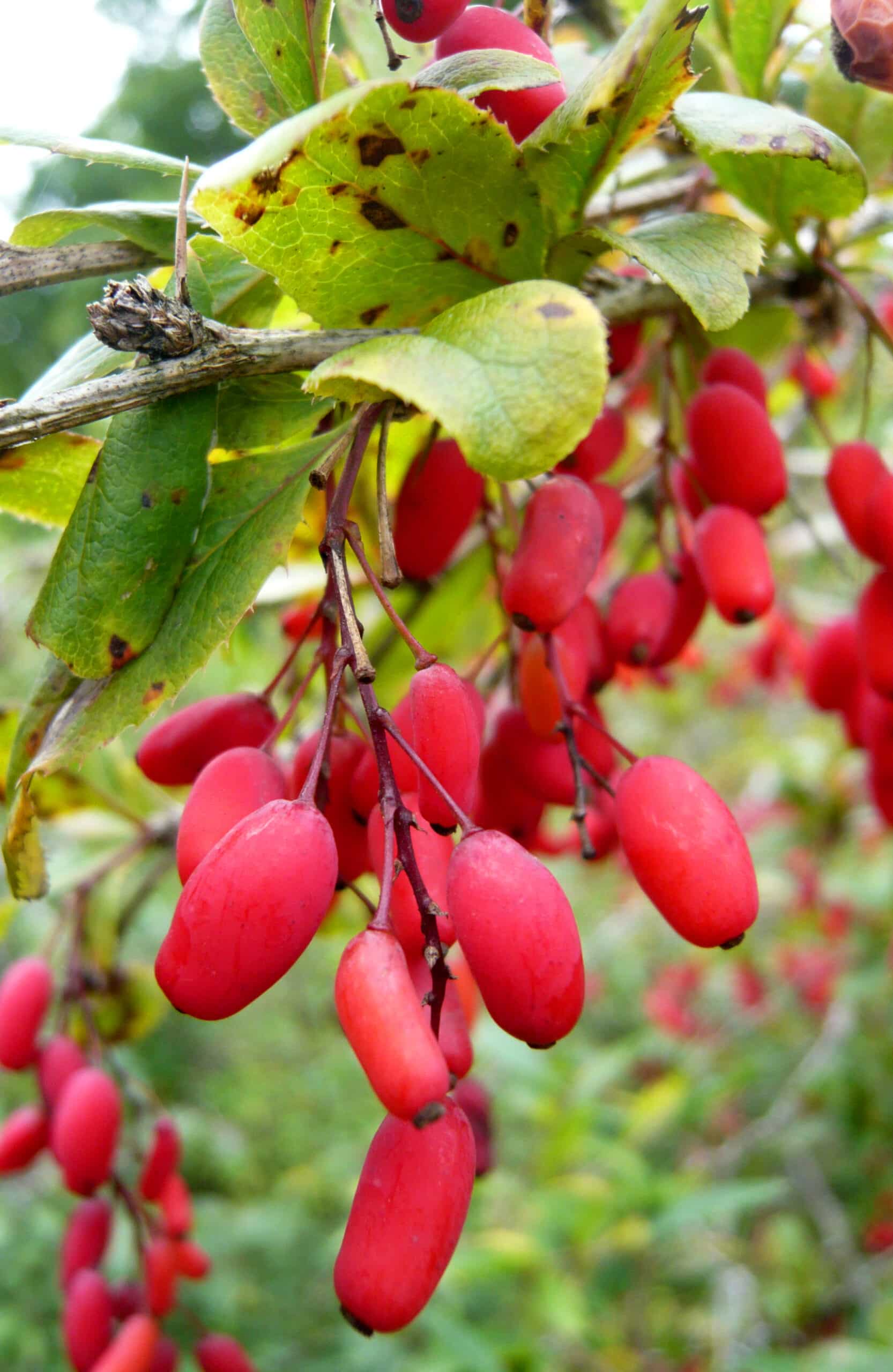
Once common throughout France,barberry was eradicated from most of our regions to prevent the spread of wheat rust, a parasitic fungus of which it is a secondary host. It is still frequently found in the Southern Alps. It’s a bushy shrub with greyish stems and strong thorns arranged in threes. The leaves, grouped in bunches, are short and broader at the top than at the base.[1]. They have a pleasant, tangy taste. Young and tender, they make a pleasant addition to salads and are refreshing to nibble as they are while walking.
The six-petal yellow flowers conceal as many excitable stamens in the corolla cup. As soon as an insect brushes against them, the stamens react instantly by tilting forcefully towards the center of the flower and spilling their pollen onto the insect’s back. In the past, this astonishing plant mechanism, one of the fastest in the kingdom, was used for divinatory purposes: young girls tickled the stamens to find out if they would soon be married, and boys to find out the feelings of their sweetheart…
In late summer, the shrub produces clusters of elongated, bright-red fruit. Too acidic to be eaten raw, they make fragrant jams, aromatic compotes and tangy sauces. Remove the thin, pointed stone by passing them through a sieve or vegetable mill. They are sometimes preserved in vinegar. They are rich in vitamin C and pectin.
At a time when only plant tinctures were known, the bright yellow bark of the root was widely used. Very bitter-tasting, it has a favorable effect on the liver when decocted.
| Barberry pickles – Remove barberries from their bunches and wash thoroughly. – Arrange in glass jars, without packing. – Boil good red wine vinegar with pepper, cinnamon and cardamom seeds. Add a little salt. – Pour over the fruit in the jars. Cover and store in a cool place. – Use like gherkins, for example with raclette. |
The Southern Alps are home to a plant that is unique in the world. The fact that it’s a shrub several meters tall rather than a tiny herbaceous plant makes it all the more astonishing. The Briançon plum or “afouatt”, endemic to the Hautes-Alpes, Alpes-de-Haute-Provence and Alpes-Maritimes, is common on the arid hillsides east of the Durance and Verdon rivers.
Its broad, toothed, oval leaves and white, five-petaled flowers are not very distinctive. Careful observation, however, reveals that the flowers form small clusters rather than being solitary or geminate.[2] as in the domestic plum. The large, round fruits resemble pale-yellow queen plums. Their abundant pulp is bland when raw, but turns sour when cooked. They make excellent jams, compotes and tarts. The kernel, with its pronounced bitter almond taste, yields an edible oil, known locally as “marmot oil” – nothing to do with the mountain animal whose fat was once reputed to treat rheumatism, but the Briançon plum tree is nicknamed “marmottier”. This oil, highly prized for pastries, was still being extracted in Ubaye during the last war.
Rock garden wonders
The mysterious-scentedhyssop hides here and there in the scree of the Southern Alps. Its stems are woody at the base and form a tuft of upright branches densely covered with narrow, elongated, opposite leaves, with clusters of smaller leaves in their axils. Long, compact spikes of intense purplish-blue flowers bloom at the top in summer.
Hyssop has the spicy aroma of peppery honey. It’s an excellent condiment for salads and a variety of hot dishes. It is also a pleasant seasoning for cereals, vegetables and meats. The plant is also used to flavor liqueurs. Hyssop is cultivated for its condiment and medicinal virtues.
Delicious infusions of flowering tops stimulate the body, particularly digestion. Hyssop helps with respiratory problems and has antiseptic properties. Its essential oil, rarely distilled, can cause nervous disorders.

You wouldn’t expect to find one of the most delectable wild lettuces among the rocks. Yet that’s where perennial lettuce thrives. Astonishing: anchored in the most ungrateful soils, its clumps of long, incised leaves, rubbery to the touch, retain all their freshness despite the scorching sun. Tender and crunchy, its leaves fill salad bowls beautifully. Despite the presence of a latex, no trace of bitterness is detectable. They’re best eaten raw, to enjoy their delicate flavor and retain their nutritional virtues, but they’re also well suited to cooking. Age does not affect them like other lettuces, and they can be harvested at any time. In midsummer, a slender flower spike appears in the center of the rosette, bearing flower heads of a surprisingly light blue color, unexpected in a lettuce.[3]. The flowers decorate dishes magnificently.
Whatever its appeal, pick perennial lettuce sparingly. Generally, just pick a few leaves per plant, leaving enough to keep it going. In south-west France, the species is protected.
| Perennial lettuce salad – Cut the perennial lettuce into pieces in a salad bowl. – Add various other seasonal herbs. – Garnish with black olives, feta cheese and sunflower seeds. Garnish with black olives, pieces of feta cheese and sunflower seeds dry-roasted in a frying pan. – Prepare a smooth dressing: mix a little sesame purée with water to obtain a homogeneous cream. Drizzle in olive oil, beating as if making mayonnaise. – Add yoghurt and dilute with lemon juice. – Season with salt. – Drizzle the dressing over the salad, decorate with a few flowers and enjoy. |
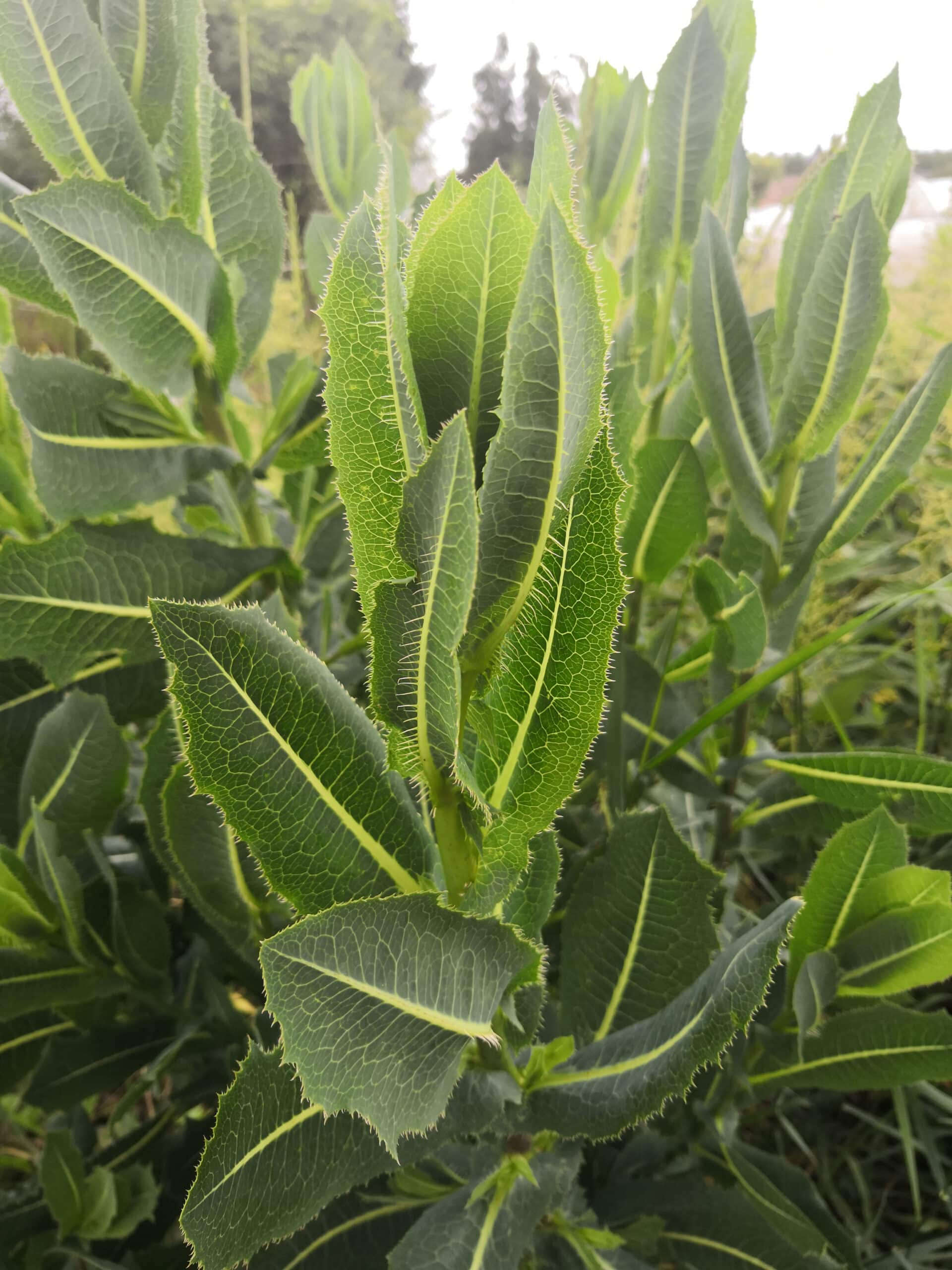
Looking at wild lettuce, it’s hard to imagine a family link with the exquisite perennial lettuce. It seems even less likely that our most common “lettuce” is descended from it. With its stiff stems, from which a goat-smelling latex drips at the slightest cut, and its glaucous, leathery leaves edged with thorns and bearing a line of fine ridges along the central vein, it seems highly inedible. The meagre yellow flower heads, however, would give some indication to the gardener accustomed to producing vegetable seeds, as they differ in no way from those of cultivated lettuces.
Come back later, the following spring, when the seeds have germinated. Young leaves cluster in light-green rosettes. Although they don’t pomace, they can be eaten in salads, just like the shapes sown in the garden. They are tender, crunchy and tasty. Later, they become tough and too bitter to eat raw. You’ll need to cook them in water, then prepare them in a variety of ways.
The latex of wild lettuces contains rubber that rolls into a ball between the fingers. Above all, it has calming properties that were once much appreciated. Fresh, it’s called “thridace”, from the Greek thridax, “lettuce”; dried, it’s called lactucarium, long used to replace opium in detoxification cures. In the middle of the 19th century, Hector Aubergier set up an industrial lettuce-growing operation on the Limagne plain near Clermont-Ferrand, using “saigneuses” to harvest lettuce juice.
The nickname ” compass lettuce” was given to the plant because its leaves point (approximately) towards the sun at midday, presenting their edges to it.
Dazzling fields
| Poppy wreath – Briefly boil poppy leaves in water and drain. – Fry onions with garlic and cumin seeds, then add the poppy, chopped walnuts, lemon juice, lightly beaten eggs and crushed dry bread (or breadcrumbs). – Season with salt. – Grease a ring mold and sprinkle with flour, then pour the mixture into the mold. – Bake in a bain-marie in a medium oven. – Prepare a Soubise purée: bake onions in their skins at 180°C for 45 minutes. Remove the onions from their skins and blend them, still hot, with the same amount of cooked rice, gradually adding chunks of butter. – Season with salt. – Carefully turn out the poppy wreath and fill the center with the purée. |
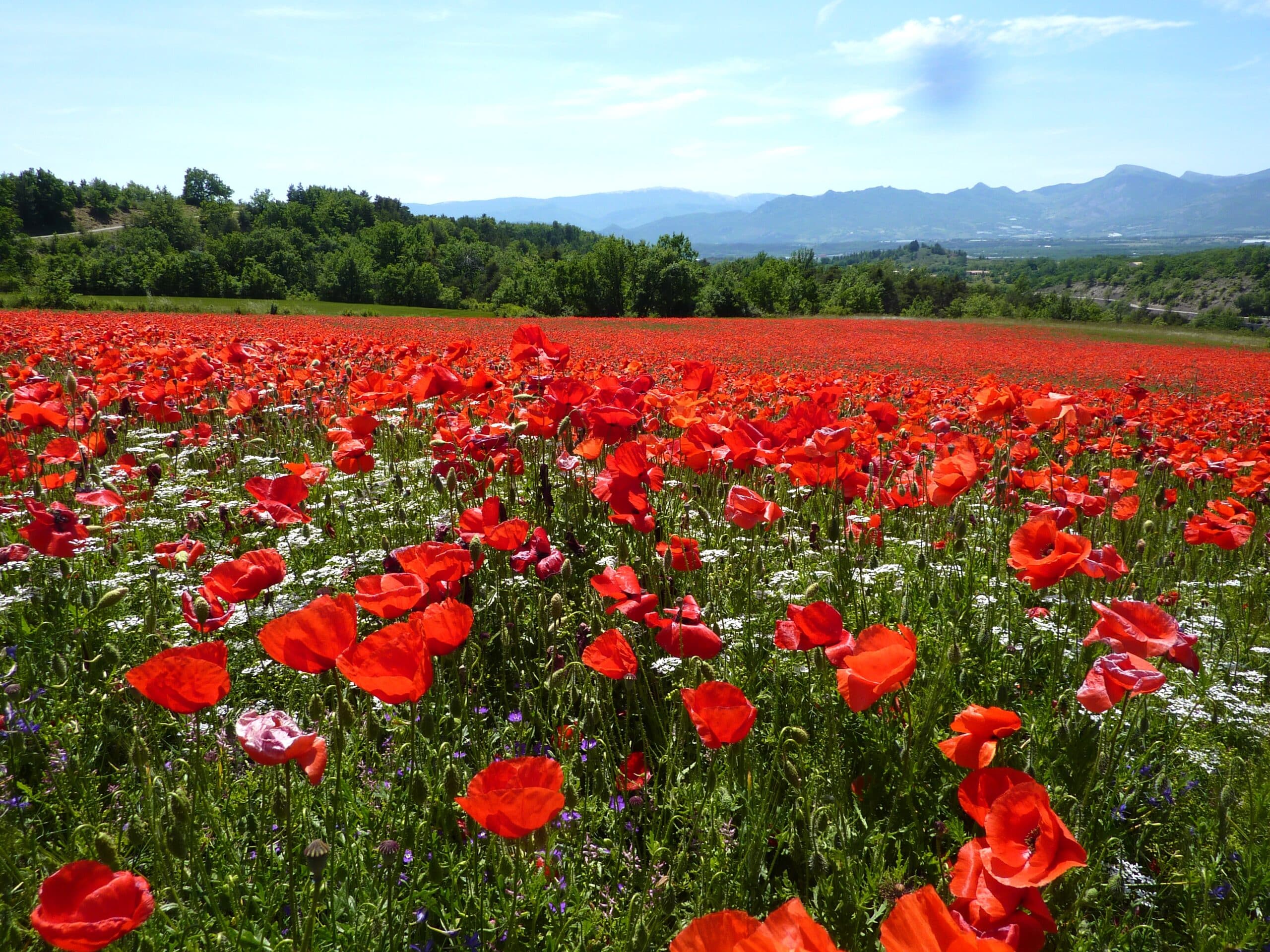
The flowers of the poppy certainly impress by their size, but their pale corolla seems quite bland next to the flamboyant poppy. One legend has it that the poppy was too proud of its beauty: to put it in its place, God allowed the devil to leave his mark. Satan placed four clearly visible black spots at the base of each of the four petals. In any case, the scarlet color of poppy flowers indicates their exotic origin. Indeed, no insect in our region can perceive this color, and there is no indigenous plant with red flowers in Western Europe. Like tulips and red roses, the poppy originated in the Middle East and spread with the “weeds” of cereal crops.

Discover our online course designed by François Couplan, an internationally recognized expert in ethnobotany with over 50 years’ experience. With 30 modules, 120 courses and high-quality theoretical instruction complemented by field courses, this unique three-year course will enable you to become a professional in the uses of plants. Accessible to all, it explores in depth the relationship between man and plants, opening up exciting professional opportunities. Join us to deepen your knowledge, explore the plant world and develop a rewarding relationship with nature.
Perhaps even more appreciated as an ornamental, with its large flowers whose five narrow, sharp sepals protrude long beyond the broad, bright-pink petals. However, farmers of yesteryear, unmoved by its beauty, detested this cousin of the carnation. Its large black seeds contain dangerous saponins and, in excess, can make flour poisonous.
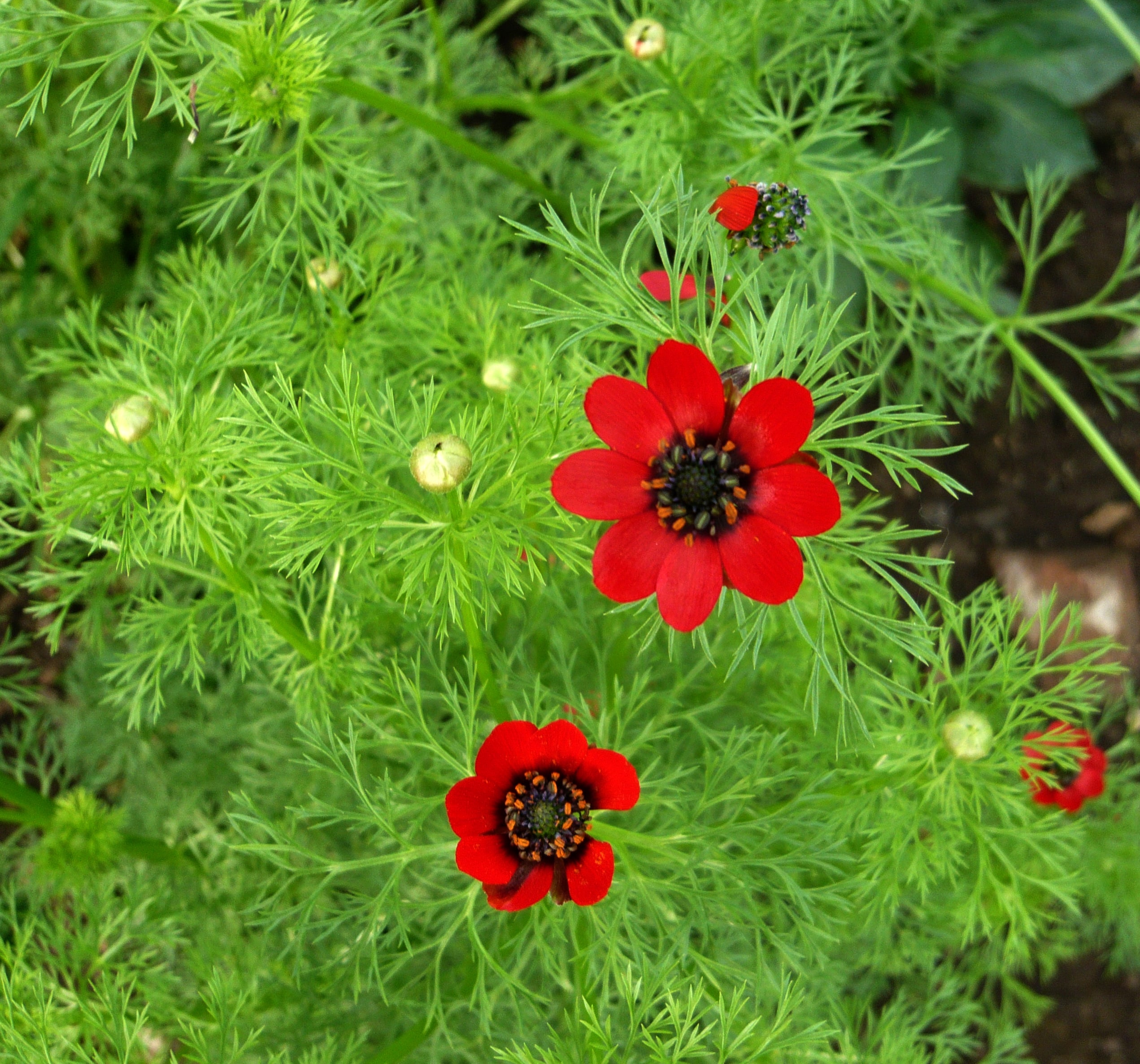
The desire to eliminate companion plants to cereals is particularly regrettable in the case of the magnificent adonis of legend, now very rare. According to ancient tradition, the Queen of Syria had a daughter named Myrrha, whom she proclaimed more beautiful than Aphrodite. Angered, the goddess inspired the young girl to fall in love with her father. Aided and abetted by her nurse, she entered his bed and conceived a child. Myrrha, overcome with shame, fled after the incest, and the compassionate gods transformed her into a myrrh tree – a kind of incense exuding in the form of drops representing the girl’s tears. Later, her son Adonis was born from the trunk of the tree. He proved to be a marvellous beauty, and Aphrodite fell madly in love with him. The couple became inseparable, but Ares was irritated by Aphrodite’s passion for a mortal and decided to eliminate her rival. So he instilled in Adonis a taste for the hunt and, in the end, Adonis was killed by a wild boar. From his blood came the red flowers known as “blood-drops”.
Summer and autumn adonis are small, spindly, single-stemmed annuals. Their leaves are finely divided into strips. The crimson petals of their delicate flowers soon fall. Spring adonis, a perennial, punctuates dry meadows with spectacular clumps crowned with large yellow flowers in May and June.
All adonis plants contain substances that increase the energy of cardiac contractions, slowing their frequency and reducing the volume of the heart in the same way as foxglove. Like dolphins and wolfsbane, adonis belong to the Renonculaceae family, which includes a large number of dangerous plants, many of them fatal.
A beautiful weed if ever there was one, larkspur brings a touch of color to untreated fields. Its slender stem bears a few leaves divided into narrow, elongated strips. Its bright blue flowers are remarkable for their irregular shape. The five sepals resemble petals, the upper one extending into a long spur, while the four petals are fused into a single petal.
Several closely related species share the fields. All are dangerous, especially their seeds. Ingestion can cause digestive, respiratory and cardiac disorders. Despite their toxicity, the seeds of some species have been used as a diuretic and vermifuge, but this use is dangerous. They were also used in applications as a parasiticide, hence the nickname “louseweed” sometimes given to the staphisaigre.
Typically Nice: mesclun

Let’s not leave the region without a detour to the Comté de Nice, home of “mesclun”. The term comes from mesclar, “to mix” in Nissard, the Provençal dialect of the Nice region, and refers to salads made from all kinds of wild and cultivated plants. The difference between the two was established not so long ago, and in many parts of the world, foraging complements cultivation without anyone being surprised. This type of culinary alliance between the wild and the domestic has been commonplace in the Mediterranean region since antiquity.
Today’s mesclun, which became fashionable in the 1980s, must include arugula, a southern crucifer with a characteristic roasted-seed flavor. It also includes ‘Feuille de chêne’ lettuce, young escarole leaves, red Treviso chicory, lamb’s lettuce, chervil and purslane. A variety of wild plants can also be used, depending on the harvest and the chef’s tastes: borage, dandelion, chicory, plantain, fennel, etc. all contribute their aromas. A good mesclun should be slightly bitter and fragrant. At the last minute, season with a dash of vinegar, a few grains of salt and a generous drizzle of olive oil. The warm goat’s cheese that is often added, a simple sign of modernity, is an attempt to hide the bitterness of this unusual and beneficial salad.
Observe, pick, taste, compare and then create your own mesclun – or rather different mixes of wild and domestic salads depending on the place, the season, your mood, your family’s tastes or those of your guests. A gastronomic reunion between nature and civilization!
[1] We call them “spatulate”.
[2] Arranged in pairs.
[3] Other species have yellow flowers.
[4] From the end of winter in mid-mountain areas.

